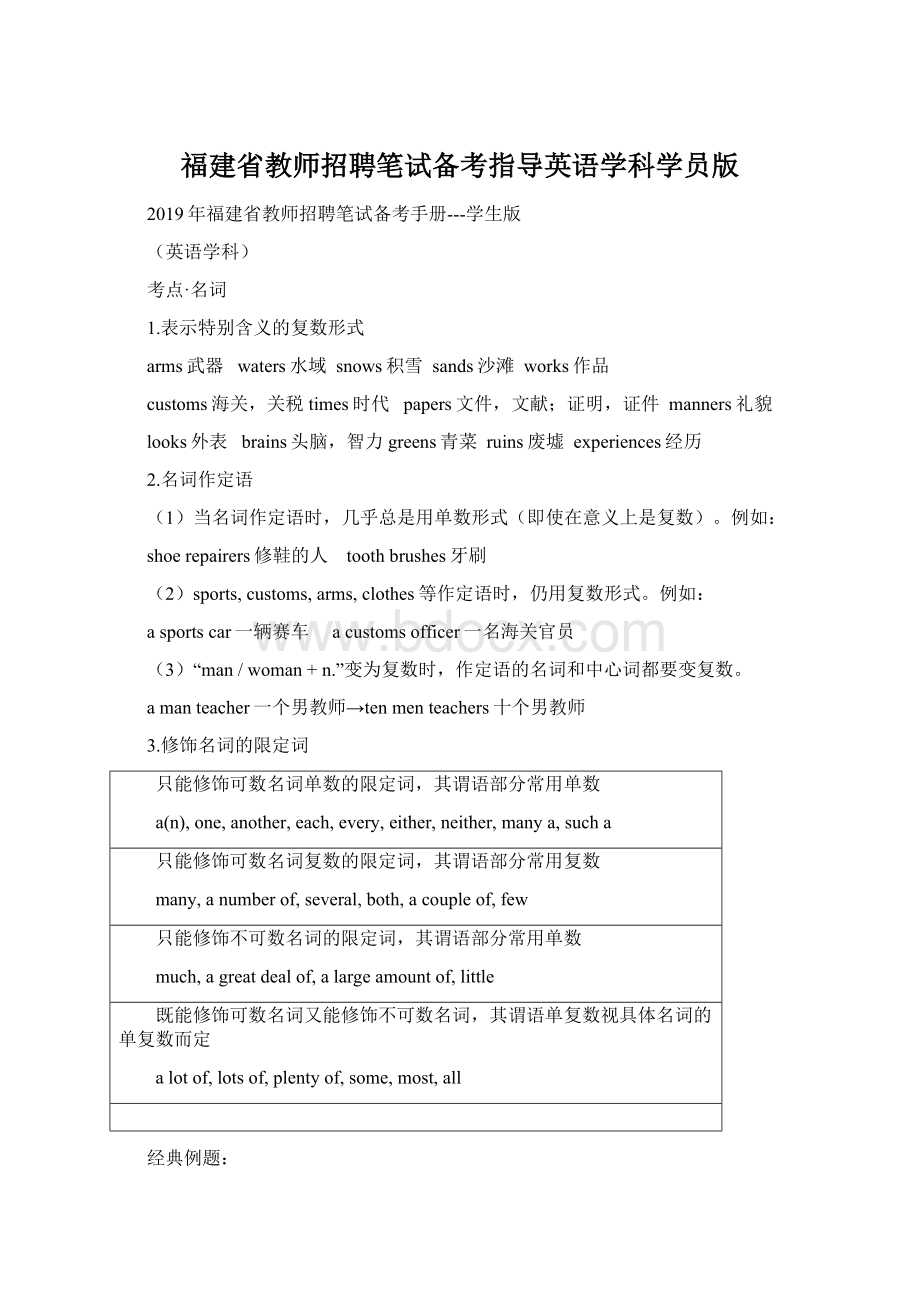 福建省教师招聘笔试备考指导英语学科学员版Word下载.docx
福建省教师招聘笔试备考指导英语学科学员版Word下载.docx
- 文档编号:17377486
- 上传时间:2022-12-01
- 格式:DOCX
- 页数:65
- 大小:285.92KB
福建省教师招聘笔试备考指导英语学科学员版Word下载.docx
《福建省教师招聘笔试备考指导英语学科学员版Word下载.docx》由会员分享,可在线阅读,更多相关《福建省教师招聘笔试备考指导英语学科学员版Word下载.docx(65页珍藏版)》请在冰豆网上搜索。

Aplaneisamachinethatcanfly.
(2)第一次提及某人、某物,非特指
Aboyiswaitingforyou.
(3)表示“每一”,相当于every,one
Westudyeighthoursaday.
(4)表示“相同”,相当于thesame
Wearenearlyofanage.=Wearenearlyofthesameage.
(5)用于人名前,表示不认识此人或与某名人有类似性质的人或事
AMr.Smithcametovisityouwhenyouwereout./ThatboyisratheraLeiFeng.
(6)用于固定词组中
abit,onceuponatime,inahurry,haveawalk
(7)用于quite,rather,many,half,what,such之后
Thisroomisratherabigone.
(8)用于so(as,too,how)+形容词之后
Sheisascleveragirlasyoucanwishtomeet.
2.定冠词的用法:
(1)表示某一类人或物
Thehorseisausefulanimal.
(2)用于世上独一无二的事物名词前
theuniverse,themoon,thePacificOcean
(3)表示说话双方都了解或上文提到过的人或事
Wouldyoumindopeningthedoor?
(4)用于乐器前面
playtheviolin,playtheguitar
(5)用于形容词和分词前表示一类人
theliving,thewounded
(6)表示“一家人”或“夫妇”
theGreens,theCangs
(7)用于序数词、形容词和副词的比较级、最高级前
Heisthetallerofthetwochildren.
(8)用于国家、党派以及江河湖海、山川群岛等名词前
theUnitedStates,theCommunistPartyofChina
(9)用于表示发明物的单数名词前
ThecompasswasinventedinChina.
3.零冠词的用法
(1)专有名词、物质名词、抽象名词、人名、地名等名词前
PekingUniversity,Jack,China,love,air
(2)名词前有this,my,whose,some,no,each,every等限制
Iwantthisbook./Whosepurseisthis?
(3)季节、月份、星期、节假日、一日三餐前
March,Sunday,NationalDay,spring
(4)表示职位、身份、头衔的名词前
LincolnwasmadePresidentofAmerica.
(5)学科、语言、球类、棋类名词前
Helikesplayingfootball/chess.
(6)与by连用表示交通工具的名词前
bytrain,byair,byland
(7)以and连接的两个相对的名词并用时
husbandandwife,knifeandfork
(8)表示泛指的复数名词前
Horsesareusefulanimals.
1.---Doyoulike_____movieBigHero6?
---Yes,itis_____interestingfilm.Ilikeitverymuch.
A.a;
anB.the;
anC.a;
theD.the;
a
2.Mr.White,whocomesfrom_____Europeancountry,hasformed_____habitofattending_____churchonSundays.
A.an;
×
;
theB.a;
the;
C.an;
D.a;
a;
1.【答案】B。
2.【答案】B。
代词
1.代词分类
(1)不定代词
one/some/any;
each/every;
none/no;
other/another;
all/both;
neither/either
(2)人称代词
主格:
I/you/he/she/it/we/you/they
宾格:
me/you/him/her/it/us/you/them
(3)物主代词
形容词性:
my/your/his/her/its/our/their
名词性:
mine/yours/his/hers/its/ours/theirs
(4)反身代词:
myself/yourself/himself/herself/itself/ourselves/yourselves/themselves
(5)指示代词:
this/that/these/those/such/some
(6)疑问代词:
who/whom/whose/which/what/whoever/whichever/whatever
(7)关系代词:
that/which/who/whom/whose/as
2.代词用法
(1)one,some与any的用法
①one可以泛指任何人,也可表特指,复数为ones。
some多用于肯定句中,any多用于疑问句和否定句中。
Oneshouldlearntothinkofothers.
---Doyouhaveanybookmarks?
---No,Idon’thaveanybookmarks.
Ihavesomequestionstoask.
②some可用于疑问句中,表示盼望得到肯定的答复,或者表示建议,请求等。
Wouldyoulikesomebananas?
Couldyougivemesomemoney?
③some和any修饰可数名词单数时,some表示某个,any表示任何一个。
Ihavereadthisarticleinsomemagazine.Pleasecorrectthemistakes,ifany.
④some和数词连用表示“大约”,any可与比较级连用表示程度。
Therearesome3,000studentsinthisschool.Doyoufeelanybettertoday?
(2)each和every的用法
each强调个别,代表的数可以是两个或两个以上,而every强调整体,所指的数必须是三个或三个以上。
Eachstudenthasapocketdictionary./Each(ofus)hasadictionary./Weeachhaveadictionary.
Everystudenthasstrongandweakpoints./Everyoneofushasstrongandweakpoints.
(3)no,noone,nobody,none的用法
①no等于notany,作定语。
Thereisnowaterinthebottle.
②noone=nobody,两者均只能指人不指物,其后通常不接of短语,作主语时谓语用单数。
Noone/Nobodylikesit.
③none既可指人也可指物,作主语或宾语,代替不可数名词,谓语用单数,代替可数名词,谓语单复数皆可。
其后通常接of短语。
Howmuchwateristhereinthebottle?
None.
Noneofthestudentsare(is)afraidofdifficulties.
④none有时暗示一种数量,即指数量上“一个也没有”,而noone或nobody则往往表示一种全面否定,即指“谁都没有”,所以在回答howmany或howmuch的提问时,通常用none,而在回答who的提问时,通常用noone或nobody。
(4)another,other,theother,others,theothers的用法
①another指“又一个,另一个”,指三者或三者以上中的任何一个,用作代词或形容词。
Idon’tlikethisshirt,pleaseshowmeanother(one).
Thetrousersaretoolong,pleasegivemeanotherpair.
②other泛指“另外的,别的”,只作定语,常与复数名词或不可数名词连用;
但如果前面有the,this,that,some,any,each,every,no,one及my,your,his等时,则可与单数名词连用。
anyotherplant,theotherday,everyotherweek,someotherreason,nootherway。
③theother表示“两者中的另一个”,常与one连用,构成one…theother…“一个……另一个……”,作定语修饰复数名词时,表示“全部其余的”。
IspendhalfofmyholidaypracticingEnglishandtheotherhalflearningdrawing.
④others泛指别的人或物,是other的复数形式,泛指别的人或物(但不是全部),不可作定语。
Somelikefootball,whileotherslikebasketball.
⑤theothers特指其余的人或物,是theother的复数形式。
Twoboyswillgotothezoo,andtheotherswillstayathome.
(5)both,all,either,any,neither与none的用法
都
任何
都不
两者
both
either
neither
三者(以上)
all
any
none
注:
all表示不可数名词时,其谓语动词用单数。
both和all加否定词表示部分否定,全部否定用neither和none。
AllofthebooksarenotwritteninEnglish.=NotallofthebooksarewritteninEnglish.
不是所有的书都是英文的。
Bothofusarenotteachers.=Notbothofusareteachers.
我俩不都是老师。
Eitherofusisateacher.我俩都是老师。
Neitherofusisateacher.我俩都不是老师。
1.Towarmhimself,thesailorsatinfrontofthefirerubbingonebarefootagainst_____.
A.anotherB.theotherC.otherD.either
2.—Whichofthetwocomputergamesdidyouprefer?
—ActuallyIdidn’tlike_____.
A.bothofthemB.eitherofthem
C.noneofthemD.neitherofthem
形容词和副词的比较等级
形容词和副词的比较等级分为原级,比较级和最高级。
比较级和最高级的构成一般是在形容词和副词后加-er和-est,多音节和一些双音节词前加more和most;
形容词的最高级前面要加定冠词the。
1.同级比较时常常用as…as…以及notso(as)…as…和thesameas。
如:
Iamnotsogoodaplayerasyouare.
2.可以修饰比较级的词有:
much,alot,even,far,abit,alittle,still,yet,byfar,any,agreatdeal。
3.表示一方随另一方变化时用“themore…themore…”句型。
Theharderyouwork,themoreprogressyouwillmake.
4.用比较级来表达最高级的意思。
★直接使用比较级
Howbeautifulshesings!
I’veneverheardabettervoice.
=ShehasthebestvoiceI’veeverheard.
anyother+n.(单)
★比较级+than+theother+n.(复)
anyoftheother+n.(复)
①Shegoestoschoolearlierthantheothergirls.
②Heworksharderthananyotherstudent.
③ChinaislargerthananyoftheothercountriesinAsia.
★比较级+than+anything/anyoneelse
Tomcaredmoreformoneythanforanythingelse.
★在比较句型中使用“no,never,nobody,nothing”+比较级等词。
①Ihaveneverspentamoreworryingday.
②Nobodycandotheworkbetterthanhedid.
5.表示“最高程度”的形容词没有最高级和比较级。
favorite,excellent,extreme,perfect。
1.Theblackhorseis_____ofthepair.
A.thestrongestB.thestrongerC.thestrongD.quitestrong
2.The_____youlearn,the_____youwanttolearn.
A.more;
muchB.more;
moreC.much;
moreD.much;
much
常见倍数关系表达方法
1.A+be+倍数+形容词(或副词)的比较级+than+B
Thishallisfivetimesbiggerthanourclassroom.
这个大厅比我们的教室大五倍。
(是我们教室的六倍)
2.A+be+倍数+as+形容词(或much)或副词+as+B
Thisbigstoneisthreetimesasheavyasthatone.
这块大石头的重量是那一块的三倍。
(这块石头比那块重二倍)
3.A+be+倍数+the+size(length,height...)+of+B
Thishillisfourtimestheheightofthatsmallone.
这座山的高度是那座小山的四倍。
(比那座小山高三倍)
4.The+size(length,height...)of+A+be+倍数+that+of+B
Theheightofthishillisfourtimesthatofthatsmallone.
1.Ataroughestimate,Nigeriais_____GreatBritain.
A.threetimesthesizeasB.thesizethreetimesof
C.threetimesasthesizeofD.threetimesthesizeof
2.It’sreportedthatwomenwithdemandingjobsarealmost_____tosufferaheartattack.
A.aslikelytwiceB.likelytwiceas
C.twiceaslikelyD.twicelikelyas
1.【答案】D。
2.【答案】C。
介词
1.表示时间
(1)表示在某时间,常用介词at,on,in等。
①用at来表示在某一时刻:
atdawn/daybreak:
在黎明
atsix:
在6点钟
atmidnight:
在午夜
at4:
30:
在4点30分
用at来表示“在……岁时”
atsixteen/attheageofsixteen:
16岁的时候
②用on来表示在星期几/某日
onMonday:
在星期一
onJanuaryfifth:
在1月5日
onChristmasDay:
在圣诞节那一天也可用atChristmas
onNewYear’sDay:
在新年那天
③用in来表示一天中的早中晚,月份,季节或年份
inthemorning/afternoon/evening
inJanuary/February
inSpring
in2014
(2)表示期间,常用介词during,for,over,within,throughout,from和to等。
①during用于已知的一段时间,包括大家熟知的节日或者某种已确切限定的时期或阶段之前
duringtheMiddleAges:
在中世纪
during1942:
在1942年中
duringthesummer(ofthatyear):
在(那一年的)夏季
duringhischildhood:
在他童年时期
②for用来表示一段时间
forsixyears:
六年之久
fortwomonths:
有两个月
forever:
永远
(3)表示其他时间概念的介词有before,after,since,until,till,between,upto等
2.表示方位
(1)at,in,on,to
at:
①表示在小地方;
②表示“在……附近,旁边”
in:
①表示在大地方;
②表示“在……范围之内”。
on:
表示毗邻,接壤,“在……上面”。
to:
表示在……范围外,不强调是否接壤;
或“到……”
(2)above,over,on在……上面
above:
指在……上方,不强调是否垂直,与below相对;
over:
指垂直的上方,与under相对,但over与物体有一定的空间,不直接接触。
表示某物体上面并与之接触。
Thebirdisflyingabovemyhead.
Thereisabridgeovertheriver.
Heputhiswatchonthedesk.
(3)below,under在……下面
under:
表示在……正下方
below:
表示在……下,不一定在正下方
Thereisacatunderthetable.
Pleasewriteyournamebelowtheline.
(4)infrontof,inthefrontof在……前面
infrontof…意思是“在……前面”,指甲物在乙物之前,两者互不包括;
其反义词是behind(在……的后面)。
Therearesomeflowersinfrontofthehouse.(房子前面有些花。
)
inthefrontof意思是“在……的前部”,即甲物在乙物的前部(乙将甲包容在内),反义词是atthebackof…(在……范围内的后部)。
Thereisablackboardin
- 配套讲稿:
如PPT文件的首页显示word图标,表示该PPT已包含配套word讲稿。双击word图标可打开word文档。
- 特殊限制:
部分文档作品中含有的国旗、国徽等图片,仅作为作品整体效果示例展示,禁止商用。设计者仅对作品中独创性部分享有著作权。
- 关 键 词:
- 福建省 教师 招聘 笔试 备考 指导 英语 学科 学员
 冰豆网所有资源均是用户自行上传分享,仅供网友学习交流,未经上传用户书面授权,请勿作他用。
冰豆网所有资源均是用户自行上传分享,仅供网友学习交流,未经上传用户书面授权,请勿作他用。


 如何打造酒店企业文化2刘田江doc.docx
如何打造酒店企业文化2刘田江doc.docx
